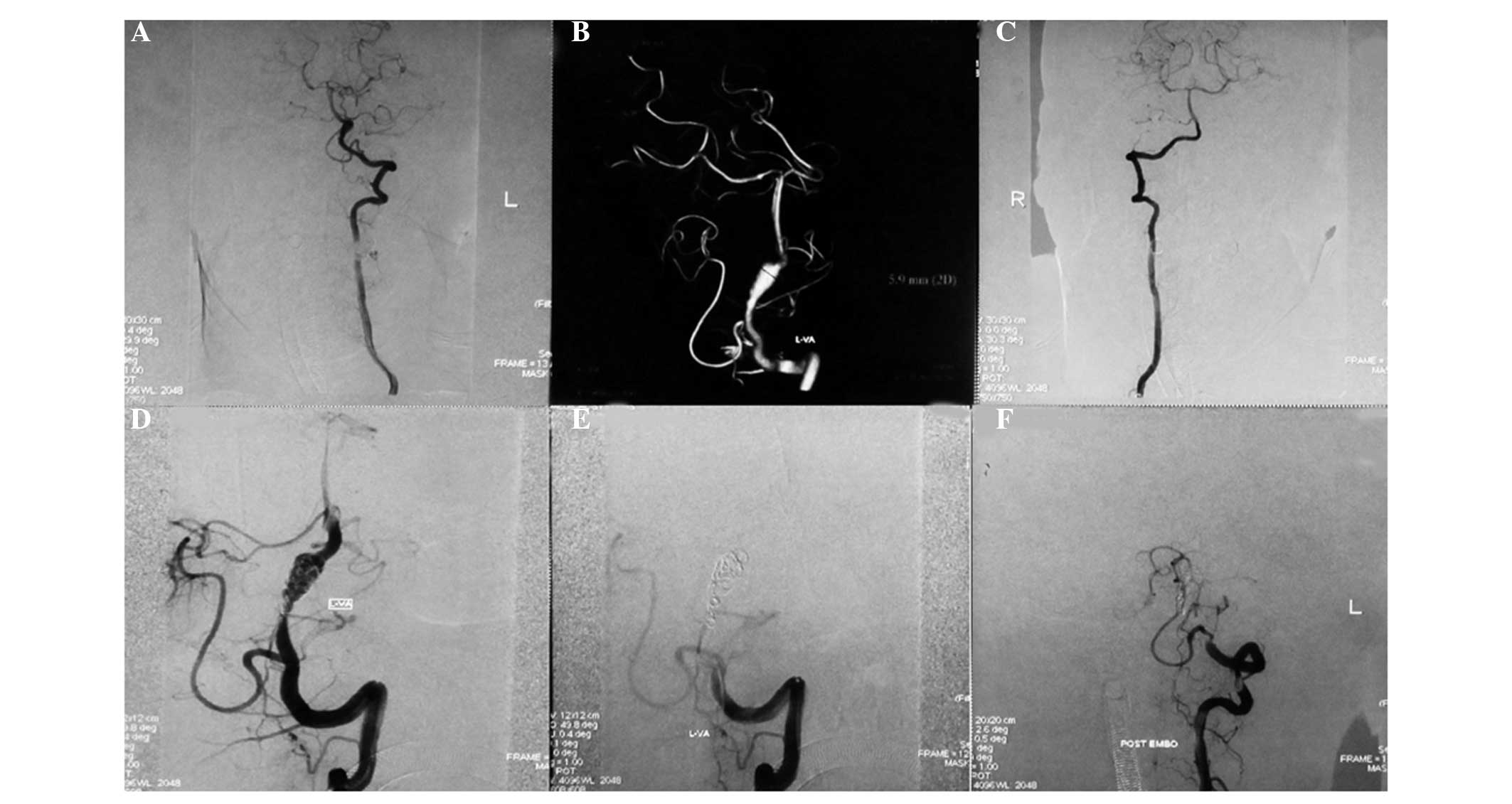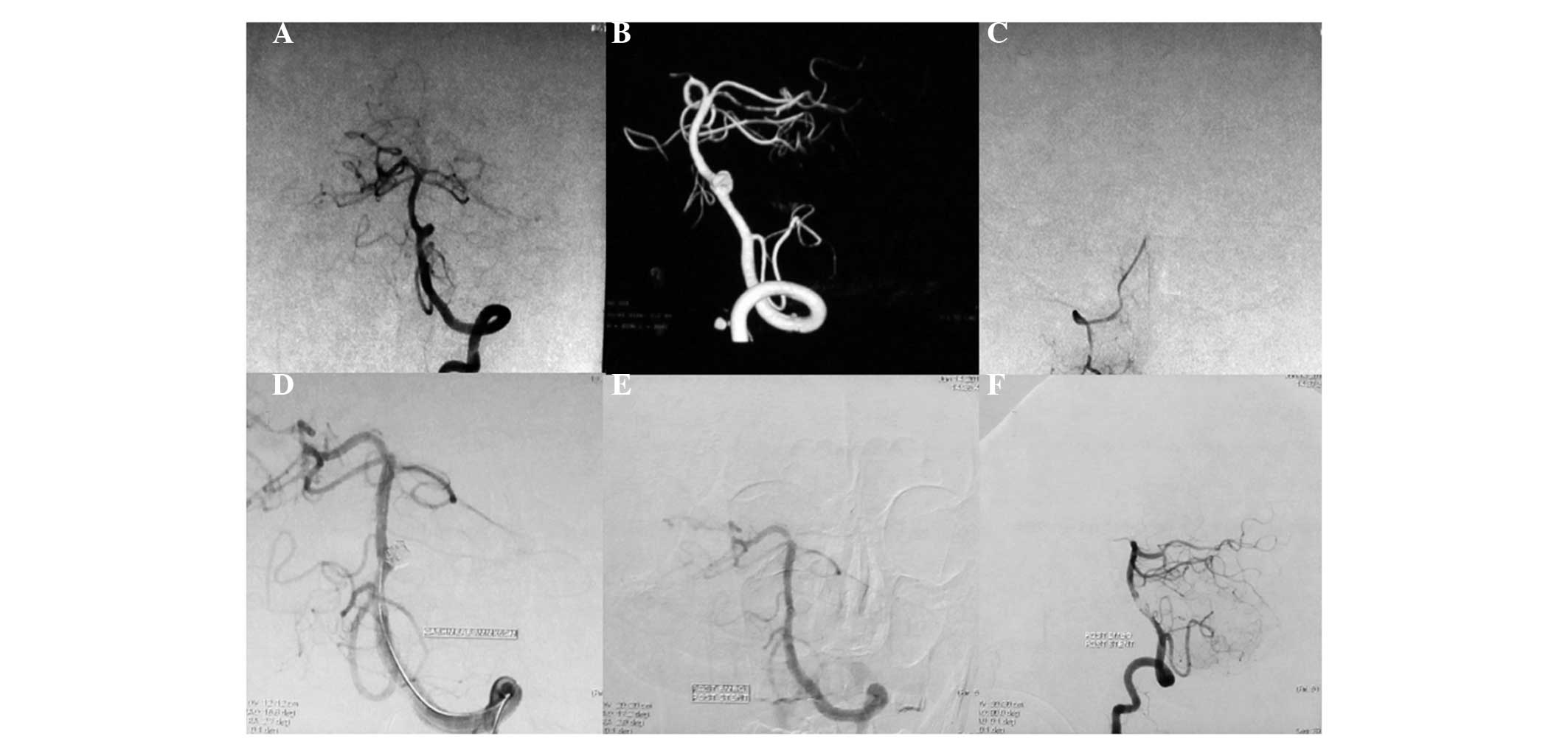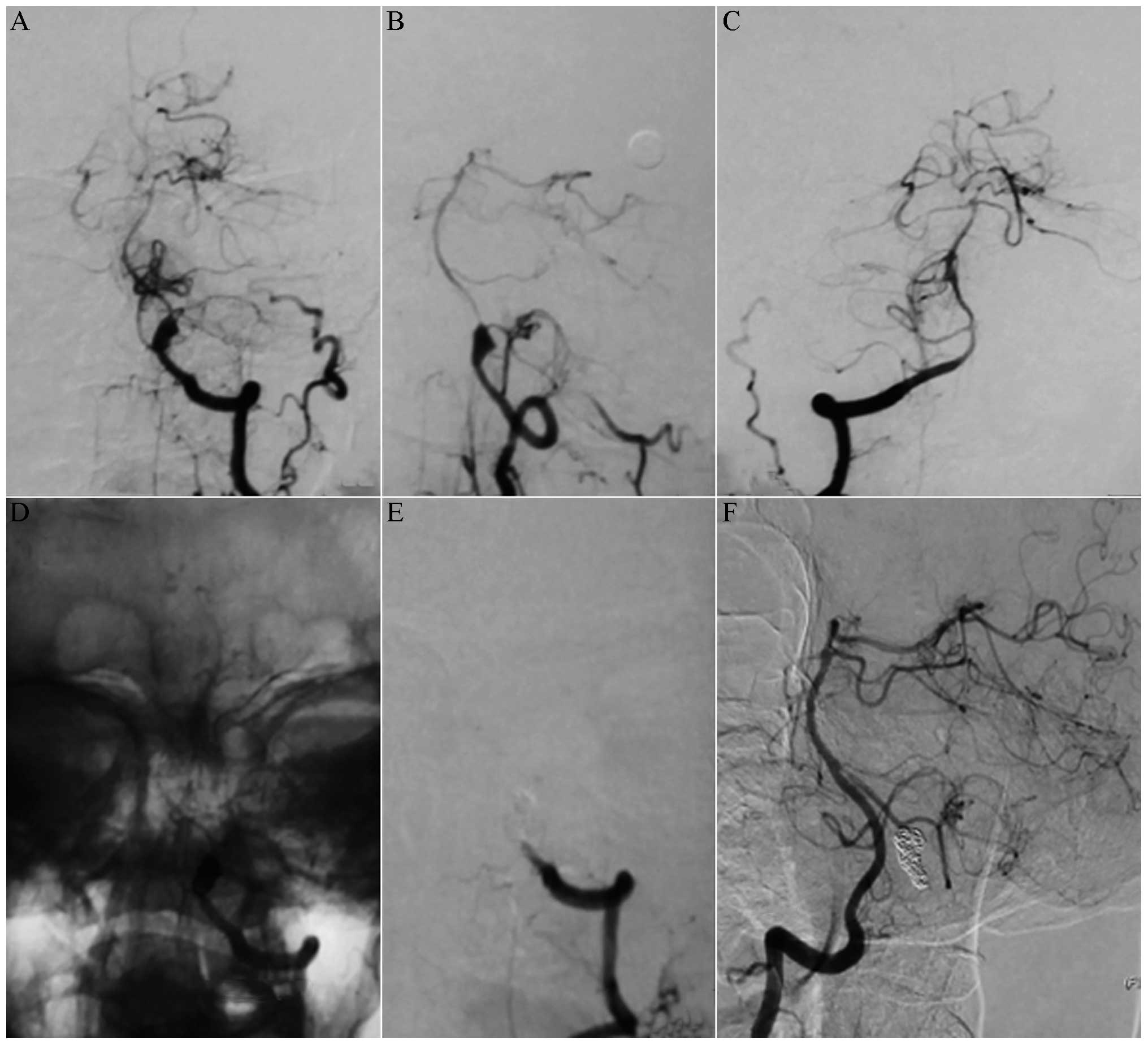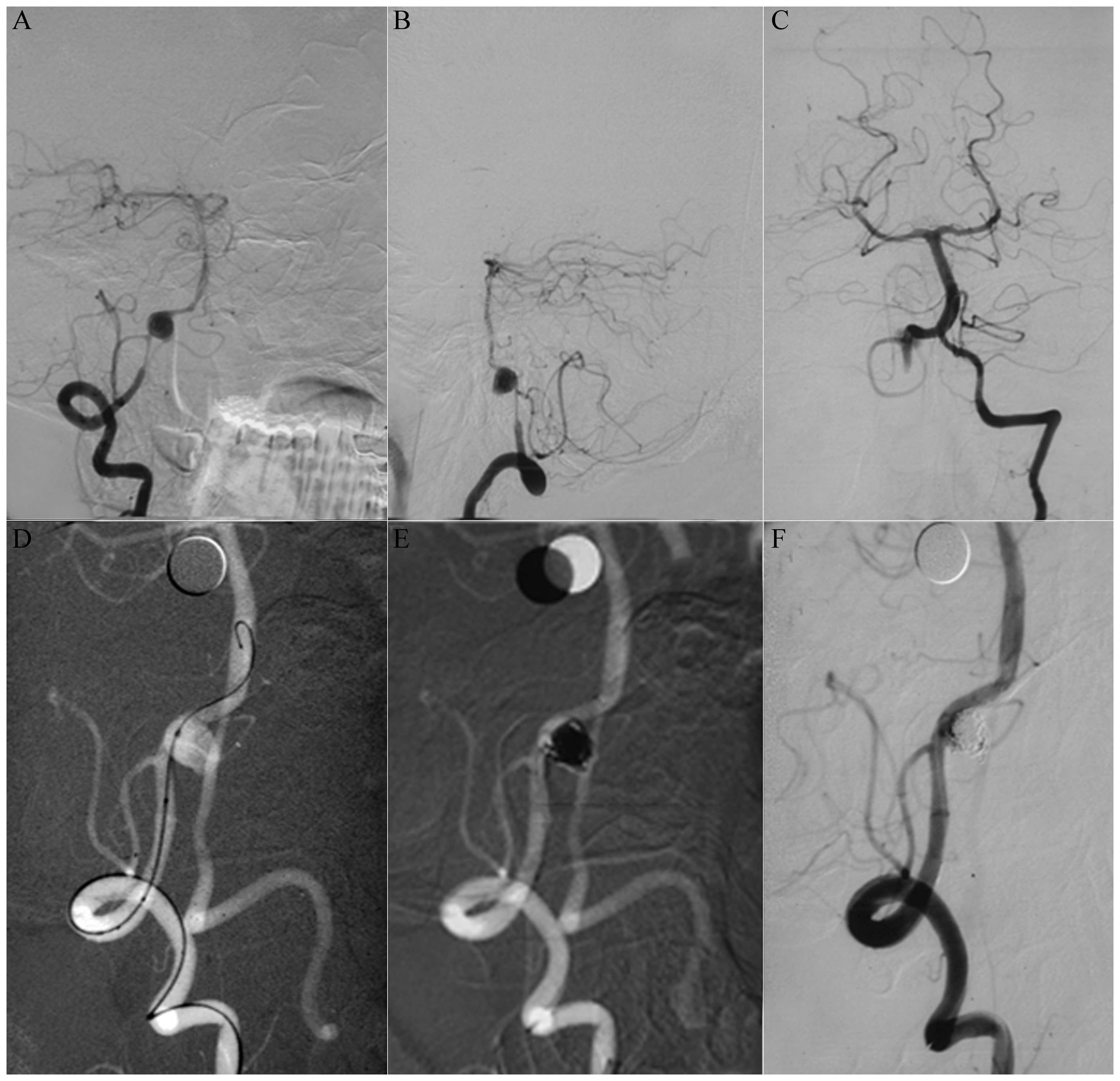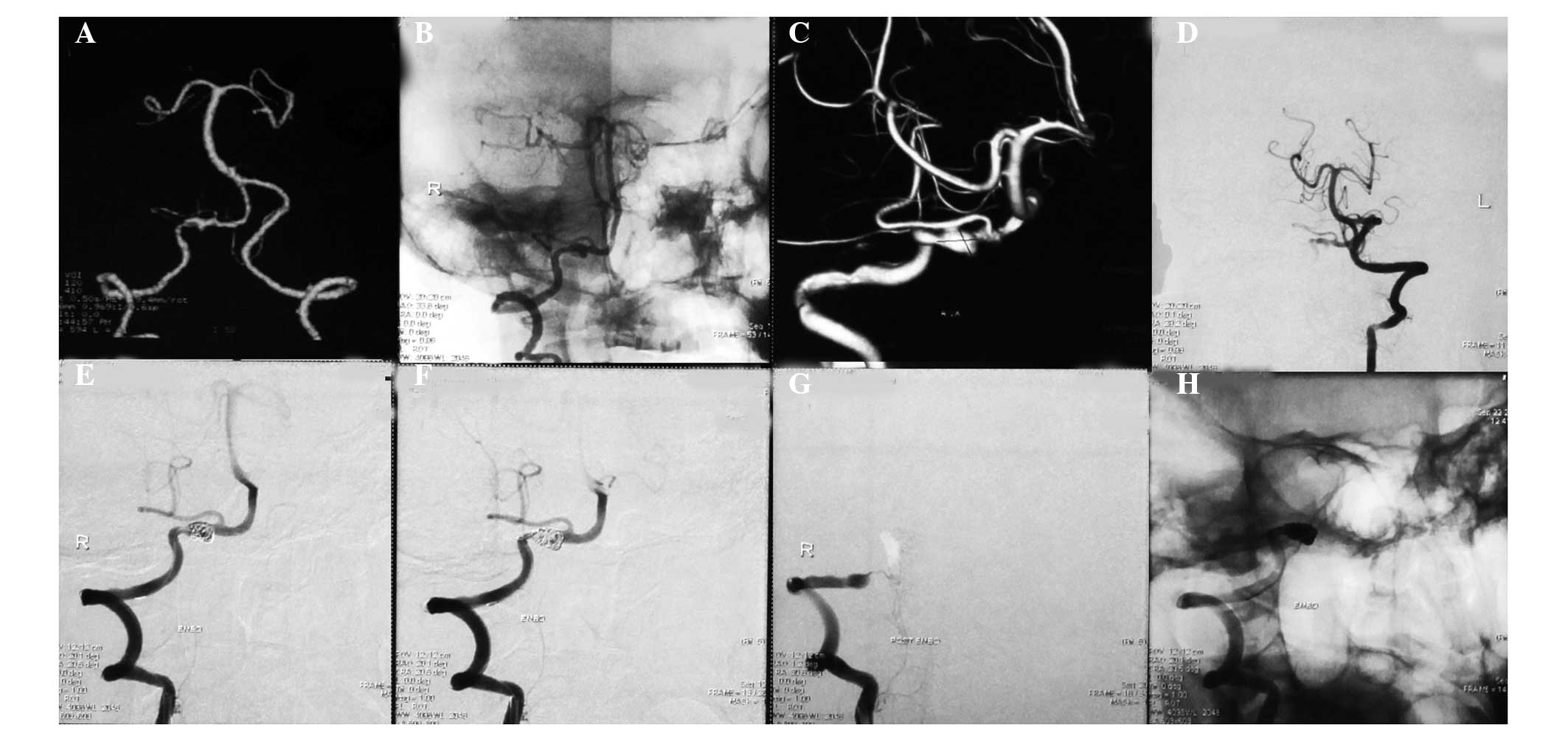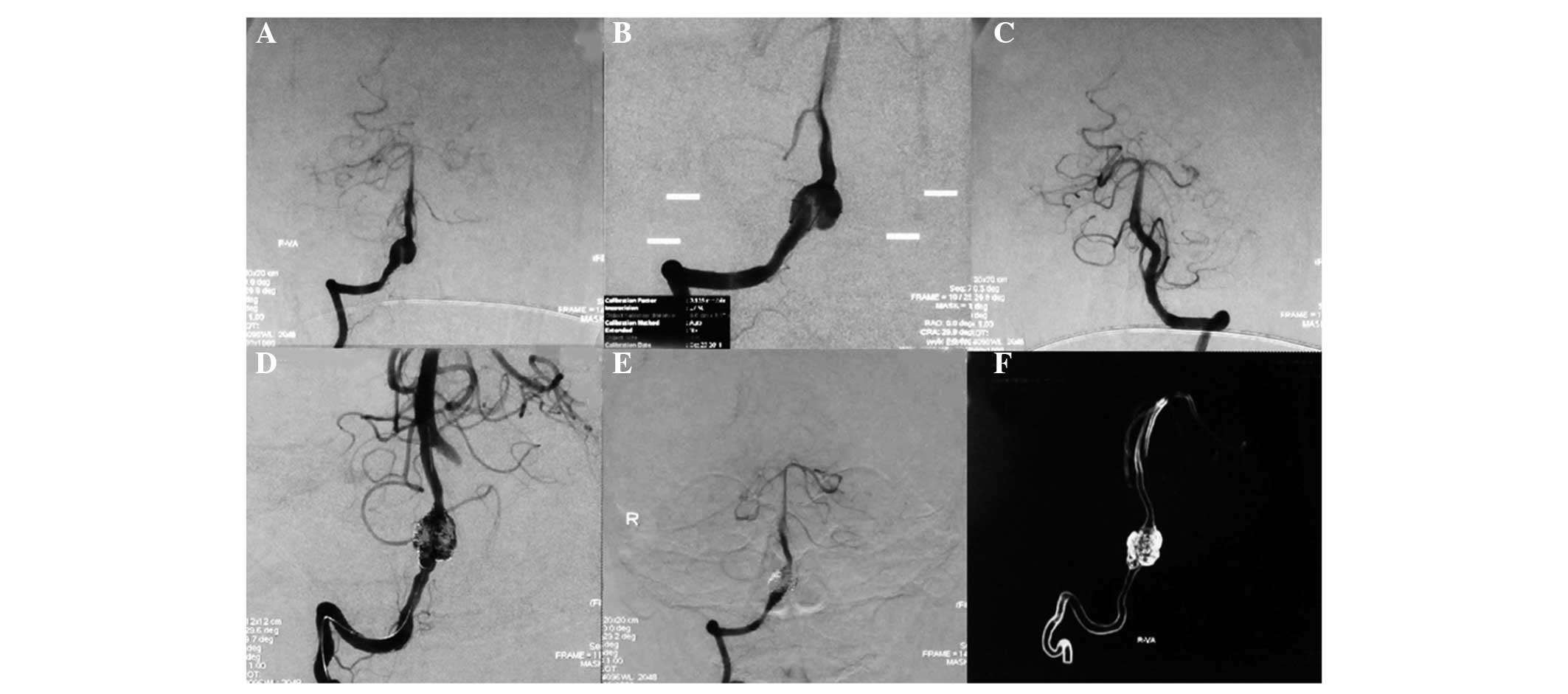|
1
|
Aoki N and Sakai T: Rebleeding from
intracranial dissecting aneurysm in the vertebral artery. Stroke.
21:1628–1631. 1990. View Article : Google Scholar : PubMed/NCBI
|
|
2
|
Kim MS: Endovascular coil trapping of a
ruptured dissecting aneurysm of the vertebral artery using
detachable coils and micro-tornado® coils. J Cerebrovasc
Endovasc Neurosurg. 15:96–101. 2013. View Article : Google Scholar : PubMed/NCBI
|
|
3
|
Jin SC, Kwon DH, Choi CG, Ahn JS and Kwun
BD: Endovascular strategies for vertebrobasilar dissecting
aneurysms. AJNR Am J Neuroradiol. 30:1518–1523. 2009. View Article : Google Scholar : PubMed/NCBI
|
|
4
|
Wang J, Sun Z, Bao J, Li Z, Bai D and Cao
S: Endovascular management of vertebrobasilar artery dissecting
aneurysms. Turk Neurosurg. 23:323–328. 2013.PubMed/NCBI
|
|
5
|
Briganti F, Cicala D, Tortora F, Leone G,
Napoli M and Maiuri F: Endovascular treatment of a giant dissecting
aneurysm of the posterior cerebral artery. A case report and
literature review. Neuroradiol J. 25:695–701. 2012.PubMed/NCBI
|
|
6
|
Ihn YK, Sung JH and Byun JH: Antegrade
recanalization of parent artery after internal trapping of ruptured
vertebral artery dissecting aneurysm. J Korean Neurosurg Soc.
51:301–304. 2012. View Article : Google Scholar : PubMed/NCBI
|
|
7
|
Shin YS, Kim HS and Kim SY: Stenting for
vertebrobasilar dissection: a possible treatment option for
nonhemorrhagic vertebrobasilar dissection. Neuroradiology.
49:149–156. 2007. View Article : Google Scholar : PubMed/NCBI
|
|
8
|
Suzuki S, Kurata A, Iwamoto K, et al:
Endovascular surgery using stents for vertebral artery dissecting
aneurysms and a review of the literature. Minim Invasive Neurosurg.
51:193–198. 2008. View Article : Google Scholar : PubMed/NCBI
|
|
9
|
Kashiwazaki D, Ushikoshi S, Asano T, et
al: Long-term clinical and radiological results of endovascular
internal trapping in vertebral artery dissection. Neuroradiology.
55:201–206. 2013. View Article : Google Scholar : PubMed/NCBI
|
|
10
|
Halbach VV, Higashida RT, Dowd CF, et al:
Endovascular treatment of vertebral artery dissections and
pseudoaneurysms. J Neurosurg. 79:183–191. 1993. View Article : Google Scholar : PubMed/NCBI
|
|
11
|
Santos-Franco JA, Zenteno M and Lee A:
Dissecting aneurysms of the vertebrobasilar system. A comprehensive
review on natural history and treatment options. Neurosurg Rev.
31:131–140. 2008. View Article : Google Scholar : PubMed/NCBI
|
|
12
|
Ali MS, Amenta PS, Starke RM, et al:
Intracranial vertebral artery dissections: evolving perspectives.
Interv Neuroradiol. 18:469–483. 2012.PubMed/NCBI
|
|
13
|
Suma T, Shibuya T, Kutsuna N, et al:
Endovascular treatment for ruptured vertebral artery dissecting
aneurysms at the acute stage. Acta Neurochir Suppl. 118:273–276.
2013.PubMed/NCBI
|
|
14
|
Ramgren B, Cronqvist M, Romner B, Brandt
L, Holtås S and Larsson EM: Vertebrobasilar dissection with
subarachnoid hemorrhage: a retrospective study of 29 patients.
Neuroradiology. 47:97–104. 2005. View Article : Google Scholar : PubMed/NCBI
|
|
15
|
Nashimoto T, Komata T, Honma J, et al:
Successful treatment of bilateral vertebral artery dissecting
aneurysms with subarachnoid hemorrhage: report of three cases. J
Stroke Cerebrovasc Dis. 21:422–427. 2012. View Article : Google Scholar : PubMed/NCBI
|
|
16
|
Mizutani T, Aruga T, Kirino T, Miki Y,
Saito I and Tsuchida T: Recurrent subarachnoid hemorrhage from
untreated ruptured vertebrobasilar dissecting aneurysms.
Neurosurgery. 36:905–911. 1995. View Article : Google Scholar : PubMed/NCBI
|
|
17
|
Yamada I, Kitahara T, Kurata A, Fujii K
and Miyasaka Y: Intracranial vertebral artery dissection with
subarachnoid hemorrhage: clinical characteristics and outcomes in
conservatively treated patients. J Neurosurg. 101:25–30. 2004.
View Article : Google Scholar
|
|
18
|
Ahn JY, Han IB, Kim TG, et al:
Endovascular treatment of intracranial vertebral artery dissections
with stent placement or stent-assisted coiling. AJNR Am
Neuroradiol. 27:1514–1520. 2006.PubMed/NCBI
|
|
19
|
Joo JY, Ahn JY, Chung YS, et al: Treatment
of intra- and extracranial arterial dissections using stents and
embolization. Cardiovasc Intervent Radiol. 28:595–602. 2005.
View Article : Google Scholar : PubMed/NCBI
|
|
20
|
Hamada J, Kai Y, Morioka M, Yano S, Todaka
T and Ushio Y: Multimodal treatment of ruptured dissecting
aneurysms of the vertebral artery during the acute stage. J
Neurosurg. 99:960–966. 2003. View Article : Google Scholar : PubMed/NCBI
|
|
21
|
Taha MM, Sakaida H, Asakura F, et al:
Endovascular management of vertebral artery dissecting aneurysms:
review of 25 patients. Turk Neurosurg. 20:126–135. 2010.PubMed/NCBI
|
|
22
|
Lv X, Jiang C, Li Y and Wu Z: Clinical
outcomes of ruptured and unruptured vertebral artery-posterior
inferior cerebellar artery complex dissecting aneurysms after
endovascular embolization. AJNR Am J Neuroradiol. 31:1232–1235.
2010. View Article : Google Scholar
|
|
23
|
Albuquerque FC, Fiorella DJ, Han PP,
Deshmukh VR, Kim LJ and McDougall CG: Endovascular management of
intracranial vertebral artery dissecting aneurysms. Neurosurg
Focus. 18:E32005.PubMed/NCBI
|
|
24
|
Peluso JP, Van Rooij WJ, Sluzewski M,
Beute GN and Majoie CB: Endovascular treatment of symptomatic
intradural vertebral dissecting aneurysms. AJNR Am J Neuroradiol.
29:102–106. 2008. View Article : Google Scholar : PubMed/NCBI
|















